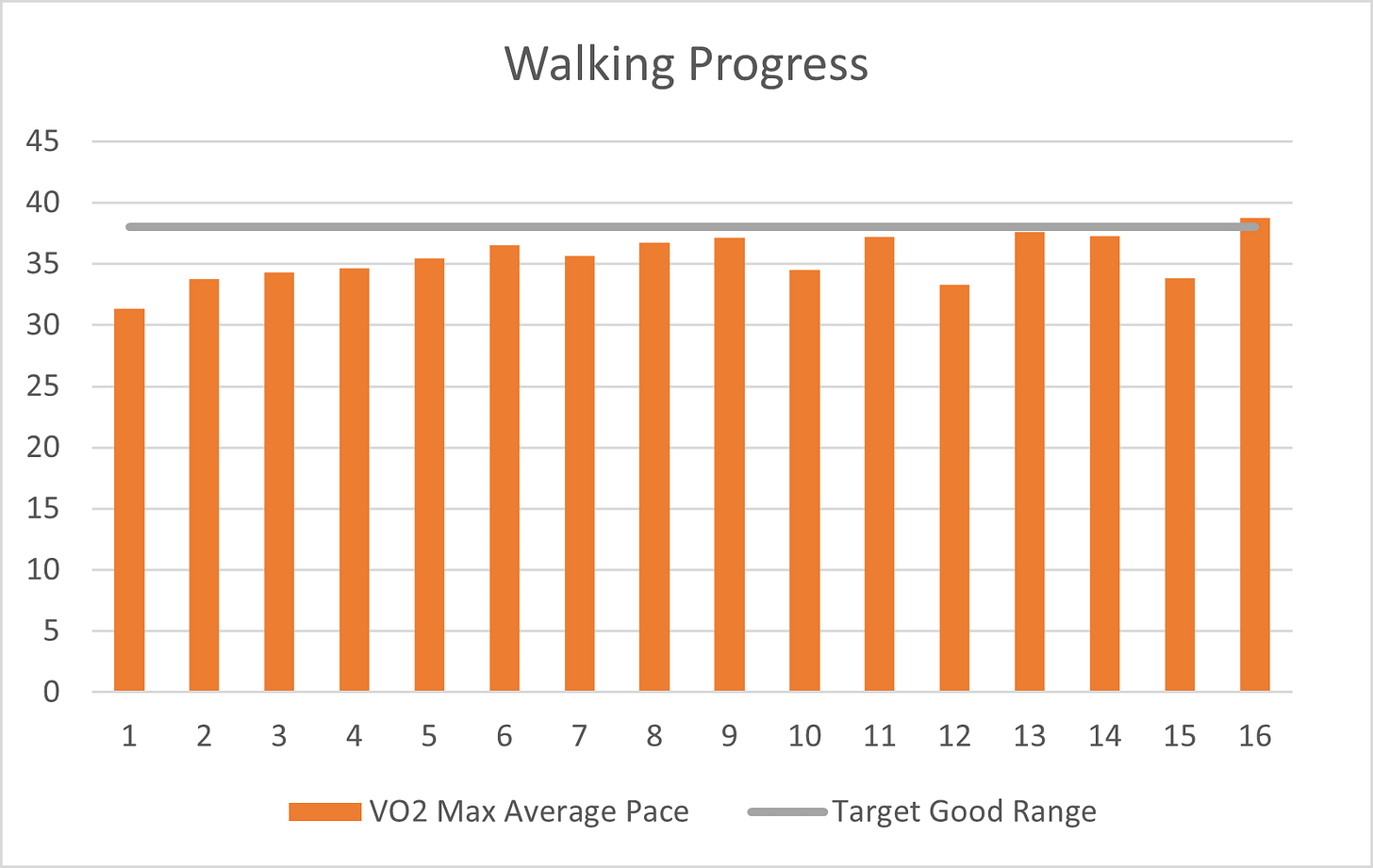#8 Need to start getting fit – try this
You know you want to get fitter but the concept of going running, attending an exercise class or going to the gym doesn’t work for you.
This post will benefit you if:
· You don’t have a lot of time to dedicate to exercise
· Are overweight and want to lose some weight
· Have been diagnosed with hypertension or high cholesterol and a doctor has said you need to exercise
· Hate running
· Want to be more active
· need to build an aerobic fitness base
· You like to exercise outside
· Want to exercise with your partner or friends
If you are in the position where you haven’t done much exercise for a while and want to start to get fit again, the danger is you go too hard too early and either get demotivated or injured.
If you are overweight, have an injury or a health condition you need to start using a low impact approach.
I’m going to set out a simple programme that involves walking which you can use as a foundation to build a solid base of fitness or if you already are doing some exercise you can use it as additional low impact sessions to improve your aerobic fitness.
Why walking?
Walking has multiple benefits:
1. Gets you moving and increases your daily activity burning more calories and controlling weight
2. If done at the right intensity will build aerobic fitness
3. Builds leg and core strength
4. Is time efficient as you can do it with no warm up and straight from your home
5. Is low impact on joints and is fast to recover from so you can do it regularly
There is walking, and there is walking
There is walking to your local shops, taking the dog for a walk, walking around work, walking to the fridge. This is all general daily activity often referred to as steps. It’s usually lower intensity done at a pace that is very comfortable.
This isn’t the walking I’m talking about. What I’m talking about is walking a 5km distance at a pace that raises your heart rate where you can talk but you have to concentrate to keep the pace up.
Over the past few years fitness influencers from the US, often associated with the US military have been advocating Rucking which is walking at pace carrying a back pack with some weight in it.
This is a good workout if you are fit, as it requires a good level of aerobic fitness and strength to do it. I would put this in the difficult category of workouts.
Microsoft has been sending me on this day pictures recently. I was mountaineering in New Zealand during November and December 16 years ago. The pictures I was sent last week were some of the hardest days I have ever done.
This picture was 5 hours into a 7 hour climb up Mount Aspiring carrying a 25kg pack, on a day it rained 1 metre of rain.
At the time I was in my late 30s and was a business consultant travelling every week. I used this approach to build the fitness to complete these long hard walks.
Back then when I was researching how to build walking fitness I went to the experts, which I believe are the British military who are renowned for their capability to walk at pace over long distances, carrying heavy packs (they call it tabbing or yomping).
I found a book on how to build a foundation of fitness to do the SAS and Royal Marine Commando selection courses. There was a lot of good advice on how to build up walking fitness in this and avoid injuries, which I used to go from a relatively sedentary management consultant in my mid 30s to climbing hard mountains in New Zealand and the Swiss Alps.
Don’t worry the programme I’m going to set out only uses some of their ideas, not the volume or intensity they would use.
So what we are looking to do is start exercising in a way that is beneficial but not too challenging and then build up, as fitness and conditioning is developed.
The start getting fit walking programme
The programme only requires that you have good shoes. You can either use hiking shoes or boots or running specific shoes. Good shoes are essential to protect your feet and lower limbs from impact and alignment injury.
Next use google maps to plot a 5km route ideally straight from the front door of your home. The route should avoid points where you may have to stop and wait to cross a road or where there are dense concentration of people that could hinder your progress. You can pick a couple of routes to vary the scenery if you like variety in your life.
You can use a treadmill if the weather is particularly bad (icy, raining, snowing, too hot, too dangerous). But treadmill walking isn’t a natural movement, so I recommend you only use this when it is impractical to walk outside.
Ideally you should also have a smart watch to monitor your heart rate and track the distance and speed you moved at. If you don’t have a smart watch you can get Apps on your phone to track your walks so you can keep a record of the distance and speed you covered.
For this programme you are going to do 4 blocks each lasting 3 weeks. This makes it a 12 week commitment. There will be two sessions a week lasting 1 hour. That’s asking for 24 hours of time over 12 weeks or 1.8% of your waking time in that 12 weeks.
The only rule is you are not allowed to run at any point. I also use the time to listen to podcasts while walking.
Block 1
This block is to get you moving and be consistent with the sessions. Each session is walking at a comfortable pace, you shouldn’t be out of breathe.
Week 1 – do two sessions covering the 5km route. Record your average heart rate and time to complete. This is your starting baseline.
Week 2 & 3 – do two sessions each week but aim to go faster each time
What you will see by the third week is you are finishing in a faster time and your average heart rate will have dropped.
Block 2
This block is to get you moving faster. You will aim to complete the 5km in 45 minutes. In block 1 you will probably be completing 5km between 60 and 50 minutes depending on fitness and how hilly the route is.
Do 2 sessions a week aiming to go as fast as you can without running or feeling pain in your feet and lower limbs. The aim is to get as close to 45 minutes each time.
Block 3
This is where the military ideas come in. An efficient way to build higher intensity without running and the associated risk of injury, is to walk up hill. It is difficult to walk faster to complete the 5km in under 45 minutes so to avoid a plateau the hill work provides a new fitness challenge.
Block 3 adds a new session. For this one you will need a hill which has a solid path and no steps. The hill should be relatively steep and be about 200 metres long.
In block 3 you will do one 5km route as before aiming to complete it in 45 minutes. The second session is a hill session.
The hill session involves setting a 50 minute stop watch and starting at the bottom walk up the hill as fast as you can and when you get to the end of the 200 meter route turn around and walk back down. You can’t run down as you could injure your knees and shins. Use the walk down to recover. When you get to the bottom repeat. Keep repeating till the 50 minutes is up. The aim is to do more repeats over time.
Block 4
This is the same as block 3 but you will add a backpack and a small amount of weight. This helps build strength in your legs, core and back. Your non weight carrying sessions will also feel much easier.
Week 1 carry an empty back pack.
Week 2 and 3 carry 3kg of weight. The easiest way is to fill up plastic water bottles. I litre of water equals 1kg.
Results you should you see:
You will see an improved aerobic capacity. In the first 12 sessions in 2022 after I had my heart injury doing 12 x 5km sessions my pace improved by 20% and I was able to complete the 5kms in close to 45 minutes.
You will increase your activity levels and burn enough calories to reduce your weight by 1.5kgs. Or to put it another way you would have to eat a significant calorie deficit 3 days a week to achieve the same result.
You will feel the conditioning and aerobic fitness as your VO2 Max improves which will improve aerobic capacity and help get hypertension and cholesterol under control. The graph shows the improvement in 16 sessions getting to a good benchmark for VO2 Max.
If you don’t like running and want a time efficient approach to start your fitness journey try this walking programme, you will be surprised how quickly you will get fit.






Walking has been my comeback activity from Long Covid. As overdoing it can cause a crash, it's a much easier activity to build up gradually. I just try to walk everywhere now. Sadly not many hills round here.